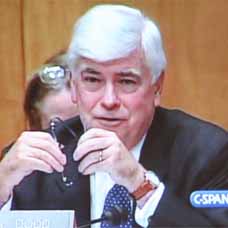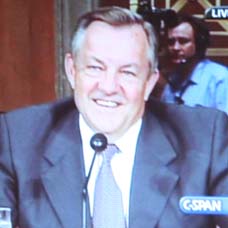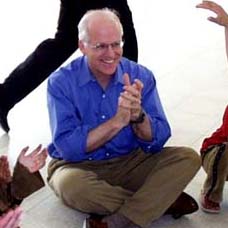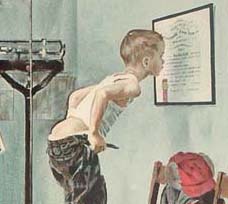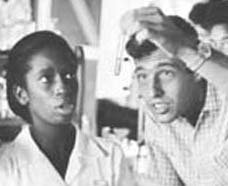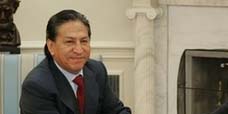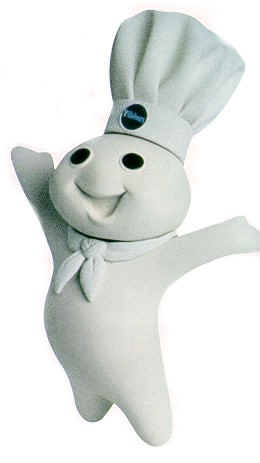
Character, which takes in about $2 million in annual revenue, has a client list that includes Cadbury Schweppes (Charts), Kellogg's, and Procter & Gamble (Charts). Among its accomplishments: putting Chester the Cheetah, Lucky the Leprechaun, the Pillsbury Doughboy, Punchy from Hawaiian Punch, and the Hamburger Helper Helping Hand on the path to self-improvement. It has also invented characters from scratch, such as the Bathroom Angels, for Angel Soft toilet paper, and a cow (working name: Bovis Frigidous) for the new Quaker Milk Chillers dreamed up by PepsiCo (Charts).
Micronesia RPCV David Altschul's marketing firm, Character, has revamped such product characters as the Pillsbury Doughboy
How the Pillsbury doughboy explains what you buy
A tiny marketing firm brings product mascots - and profits - to life.
FORTUNE Small Business Magazine
By Carlye Adler, FSB Magazine
September 15 2006: 5:50 AM EDT
(FSB Magazine) -- When PepsiCo wanted to differentiate its Mug root beer from competing products, it called David Altschul, the co-founder of a small marketing firm called Character in Portland, Ore., who helped create a mysterious bulldog to spice up Mug's soda cans.
When General Mills (Charts) decided to invigorate Buzz, the Honey Nut Cheerios bee, Character was hired to give him a makeover. And when Pepperidge Farm committed to spruce up its Cheddar gold fish icon, the brand experts at Character named him Finn, shifted his sunglasses at the top of his head, and moved him into a colorful community. His school, as seen on TV ads launched in January, now includes Gilbert, a shy pretzel gold fish; Brooke, a smart Parmesan fish; and a daredevil XTreme, from the Flavor Blasted line of Gold Fish.
Chances are that unless you're in the advertising world, you've never heard of Character, a six-person company that launched in 2002. Walk down any supermarket aisle, though, and it becomes clear that the firm's work has already seeped into the collective unconscious of U.S. consumers.
Character, which takes in about $2 million in annual revenue, has a client list that includes Cadbury Schweppes (Charts), Kellogg's, and Procter & Gamble (Charts). Among its accomplishments: putting Chester the Cheetah, Lucky the Leprechaun, the Pillsbury Doughboy, Punchy from Hawaiian Punch, and the Hamburger Helper Helping Hand on the path to self-improvement. It has also invented characters from scratch, such as the Bathroom Angels, for Angel Soft toilet paper, and a cow (working name: Bovis Frigidous) for the new Quaker Milk Chillers dreamed up by PepsiCo (Charts).
Good character sells
Even more impressive than Character's client list are its results. PepsiCo saw root beer sales increase immediately after replacing its former frosty mug logo with its new character, Dog.
Honey Nut Cheerios' Buzz got a revamped look, voice, and hive designed to capture his "bee-ness" (a previous problem was that he acted more like a person than an insect), and the product jumped from the No. 5 cereal sold in the U.S. to its current spot at No. 2.
And though it's still too early to measure how Finn and friends have been received by the marketplace, the folks at Pepperidge Farm in Norwalk, Conn., say they're pleased. "This is a big departure for us, but it just feels so right to the values of our brand," says Connie Olsen, director of brand equity and communications at Pepperidge Farm. "You're going to see Finn around for a long time."
With degrees in history and economics from the University of Chicago and a résumé that includes two years in the Peace Corps in Micronesia and a stint teaching photography in the slums of Chicago, Character co-founder David Altschul, now 61, makes an unlikely adman. He was always passionate about narrative, though (every grade-school snapshot shows him sitting in a corner reading a book), and he eventually fell into freelance filmmaking.
Ironically, one of his first films, Why Do You Buy?, taught kids about consumerism. His projects included everything from programs for public TV to features and animated films, commercials, and rock & roll documentaries. (He followed the band Heart on tour in Texas and Japan in 1978.) Altschul joined an animation shop in Portland called Will Vinton Studios in 1982 and spent the next 20 years working on the firm's animated television commercials.
Dancin' Raisins
The biggest hit under his tenure was the California Raisins, which became a pop-culture phenomenon. Within weeks of the commercial's launch, kids donned black garbage bags and trick-or-treated as the Raisins for Halloween; later the Raisins got their own special on TV.
That success put Altschul and his team on the map as experts in character development, but it also helped them formally define their theory about how such mascots can sell products. Most important was infusing each character with a distinct personality, a tenet that helped the studio revamp the M&M characters. (Ad agency BBDO wrote the script and fashioned the campaign, and Vinton Studios handled the animation.)
Vinton treated the characters like hired performers and ensured that each was unique, with the yellow M&M a bit dopey and the red M&M exhibiting a Napoleon complex. Again, personality resonated with the consumer: Within three years of the M&M character launch, sales were up $250 million.
Although Vinton was regarded as a creative powerhouse, it struggled financially. Not long after trying and failing to go public, the company was acquired by Nike (Charts) founder and Vinton shareholder Phil Knight. Altschul, the No. 2 executive at Vinton, left during the transition.
"I had to make sure we were not going to be held hostage to a company going downhill," he says. With Vinton colleague and fellow former filmmaker Jim Hardison (whose early work includes what he describes as a "terrible" film called The Creature From Lake Michigan) and a former Coca-Cola (Charts) marketing executive, Brian Lanahan, Altschul spun off from Will Vinton and set up a new company called Character.
He immediately sought to differentiate it from other advertising and marketing shops, not only through its focus on creating and revitalizing brand characters but also through the process it uses. According to the company's approach, effective brand characters can't simply mirror the consumer. This cardinal sin is what Altschul says caused the downfall of the hip-hop Colonel Sanders, who was designed to engage KFC's "street" clientele, and the modernized Betty Crocker, who was a digital hybrid of multiple women who represent the brand's target audience.
People "connect emotionally with characters whose struggles are familiar to them, not with characters who superficially look or act like them," says Altschul. A look at long-reigning beloved characters proves his point: Tony the Tiger has an oversized ego, the Maytag repairman is a lonely perfectionist, and Sonny from Cocoa Puffs teeters on the brink of insanity.
Expressing the brand story
Of course, Altschul's job is more than just dreaming up troubled characters that tap into a consumer's tendency toward schadenfreude. Creating characters is "not about making stuff up but discovering the story inherent in the brand," explains Hardison, the firm's creative director.
To find that story, Altschul runs something called Character Camps, three-day offsite retreats (sites have ranged from the Teahouse in Portland's Japanese Garden to a 300-acre ranch in Texas to the coffee-growing regions of Colombia), where the brand's managers, package designers, web developers, and advertising executives convene with the staff from Character - and a few freelance sketch artists and actors - to develop fictional spokescreatures that connect with the consumer.
Character runs about eight to 12 camps a year - cost: around $150,000 - and even among creatives in the advertising world, the experience is unique. First, Character downloads its theories about things such as conflict, story framework, and what the company calls "universal human truth."
It's not all as complicated as a semiotics seminar; participants also get to hone their skills by sharing personal stories and doing improvisation with professional actors. ("Improv? You've got to be kidding me," Pepperidge Farm's Connie Olsen remembers thinking, not relishing the prospect of looking silly in front of co-workers.)
The pros at Character claim that the hands-on approach works. "When people are up on their feet performing, they can't be analytical and they articulate stuff normally in their unconscious," says Hardison. Altschul and Hardison also spend a lot of time asking questions about the product, category, brand, and strategy. "It's like them playing detective and us playing witness," says Chad Dick, a director of marketing at PepsiCo who worked on the Milk Chillers product. "There was a lot of 'Why this?' or 'Why that?' "
Every idea and utterance from the brand executives is recorded, and staffers at Character spend the next several hours going through their easel-sized pages of notes. Mostly they are searching for any conflicts within the brand. Through this process Character realized that Maytag had to justify its established dependability with its newer penchant for innovation.
They realized that Quaker's Milk Chillers would have to come to terms with promoting the wholesomeness of milk and the deliciousness of its decadent flavor. And for Mug, they discovered a conflict in balancing the root beer's exotic yet familiar flavors.
The next step is finding a character that embodies the brand conflict. At the Mug Character Camp, a wild boar was an early contender. "A pig is familiar, but a wild boar is more exotic, and it's low to the ground, so it hangs out in the forest close to the roots," says Hardison.
Also in the running, a Sasquatch, or Bigfoot character ("Like a man, which is familiar, but more exotic because it lives in the wild") and a dog - specifically a bulldog which, like root beer, is tenacious, thick, brown, and has a lot of "nose." The consensus at camp was that the dog was the hands-down winner - something supported later by focus groups.
The folks at Character work until about 4 a.m. doing much of the conflict scouring and character honing on their own. Hardison stays up the entire night writing the team's discoveries in a 12- to 15-page story, which he presents to the brand leaders the next day. (For Mug root beer, the elaborate story started with a Mug delivery driver named Tex discovering an abandoned bulldog puppy, which he reluctantly keeps and simply calls "Dog." Later, after a crash, Dog and Tex are separated - paving the way for future web and TV ads following the character's quest to be reunited with his master.)
For the people who breathe these brands, witnessing these characters come to life can be a mesmerizing moment. "It's like waking up on Christmas morning," says Connie Olsen at Pepperidge Farm. "Jim read the tale of Finn, and it was breathtaking. His world unfolded and had meaning - we understood our brand better."
Writing the book
After the camp, Character's employees return to Portland and produce a comprehensive Character Book. The Milk Chiller's sunglasses-sporting bovine is 45 pages, and the book for the Trix Rabbit is an impressive 74.
Camp attendees say the book serves as a bible documenting the brand's "conflict and truth" - its essence - as well as every aspect of the character's personality, world, and relationships. As far as revealing specifics, most brand managers won't tell. ("This is so core to what we're doing now and what we will be doing in the future - it's just too doggone proprietary," says Olsen.) Brand managers will reveal that the book offers specifics that provide a framework for how to stay true to a character's core as he grows and develops.
"Other agencies will try to take away from Dog, from his roots. They say we can dress Dog up or have him walk upright, or talk," says Rita Stockett, director of product innovation at PepsiCo. "That will never happen."
While the folks at character may do something unique - "Character creates people out there who are our friends," says John Thomas, former head of brand equity at Maytag and now an advertising professor at Iowa State - they, like the characters they help create, are not flawless superheroes. Even the most compelling character can't make a shoddy product soar off the shelves or save an ailing company from extinction.
Case in point, the Maytag repairman and "apprentice" character Altschul and his team created were memorable brand characters but not powerful enough to prevent an uncertain future for the company. Maytag struggled and was acquired in March by rival Whirlpool, which no longer uses the apprentice.
Character-less
After participating in 46 projects over four years, Character is now expanding its repertoire to organize camps for companies that don't have a character and don't want one. The first project in this category: Cheerios. Although the brand never had - and never will have - a critter (as characters are known in the business), the brand managers at Cheerios thought there were lessons to be gained from Altschul and company.
"We had the No. 1 cereal and we treated it as perfect, but we learned the way to make it authentic was to acknowledge that it is not perfect," says Ann Simonds, president of the baking division at General Mills.
In other words, acknowledge the occasional cereal-related mess. "It's okay for people to eat Cheerios for dinner," says Simonds. "Or, so what if the box is ripped? And why not celebrate that Cheerios are all over the floor of the car?"
In recent commercials General Mills stopped plugging Cheerios as the flawless heart-healthy cereal and focused instead on heartwarming stories about family connections - one involving a father diagramming football plays for his son using Cheerios.
Since Character's foray into noncharacter brands with Cheerios, it has worked on similar, noncritter projects for Chrysler, Old Spice, Tostitos, and Wal-Mart. In many ways it's a new direction for the company as well as the one Altschul was working toward all along. "After four years we proved our model, and now we're going back to the territory we wanted to occupy in the first place - bringing story to every brand," he says. But how does a company called Character with proprietary Character Camps and a résumé of brand characters evolve into a business that's character-free?
It sounds like the makings of a conflict - maybe even a superconflict. Perhaps, if navigated right, Altschul would say that's what will make Character more compelling than ever.
Which commercial mascots have been the most memorable ones for you? Have any influenced the way you think about marketing your own product or service? And do you have a mascot for your company? If so, how did you choose it? Let us know by writing to fsb_mail@timeinc.com.
